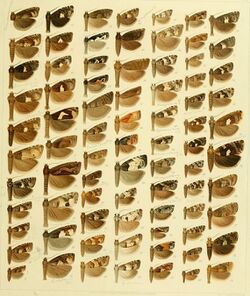Biology:Epinotia nemorivaga
| Epinotia nemorivaga | |
|---|---|

| |
| in Kennel Die palaearktischen tortriciden figure 59 | |
| Scientific classification | |
| Domain: | Eukaryota |
| Kingdom: | Animalia |
| Phylum: | Arthropoda |
| Class: | Insecta |
| Order: | Lepidoptera |
| Family: | Tortricidae |
| Genus: | Epinotia |
| Species: | E. nemorivaga
|
| Binomial name | |
| Epinotia nemorivaga (Tengstrom, 1848)[1]
| |
| Synonyms | |
| |
Epinotia nemorivaga, the bearberry bell, is a species of moth in the family Tortricidae. It is found in Europe (from Fennoscandia and northern Russia to the Iberian Peninsula and Italy, and from Ireland to Poland )[2] and Asia (China : Henan, Sichuan, Guizhou, Shaanxi).[3]
The wingspan is 10–12 mm.[4] The face and palpi are pale brownish. The forewings are silvery- whitish, finely strigulated with fuscous. The costa is posteriorly strigulated with dark fuscous and white. There are some scattered dark fuscous strigulae . The basal patch with edge somewhat bent, the central fascia with posterior median projection, and an irregular spot touching termen in middle are all dark fuscous. The termen is hardly sinuate. The cilia have a white subapical dash. The hindwings are grey.The larva is pale yellowish; head dark brown :[5]
Adults are on wing in June and July in western Europe.[6]
The larvae feed on Arctostaphylos alpinus and Arctostaphylos uva-ursi. The larvae mine the leaves of their host plant. The mine starts as a corridor. Later, the larva leaves the corridor and starts making a large full-depth blotch. The larva leaves the blotch and moves to a new leaf, connecting both leaves with silk. The larvae are a dull grey-green color with a shining black head. They can be found from September to May.[7]
References
| Wikimedia Commons has media related to Epinotia nemorivaga. |
- ↑ tortricidae.com
- ↑ Fauna Europaea
- ↑ Catalogue of Eucosmini from China (Lepidoptera: Tortricidae)
- ↑ Hants Moths
- ↑ Meyrick, E., 1895 A Handbook of British Lepidoptera MacMillan, London pdf
 This article incorporates text from this source, which is in the public domain. Keys and description
This article incorporates text from this source, which is in the public domain. Keys and description
- ↑ UKmoths
- ↑ "bladmineerders.nl". http://www.bladmineerders.nl/minersf/lepidopteramin/epinotia/nemorivaga/nemorivaga.htm.
Wikidata ☰ Q11967644 entry
 |

